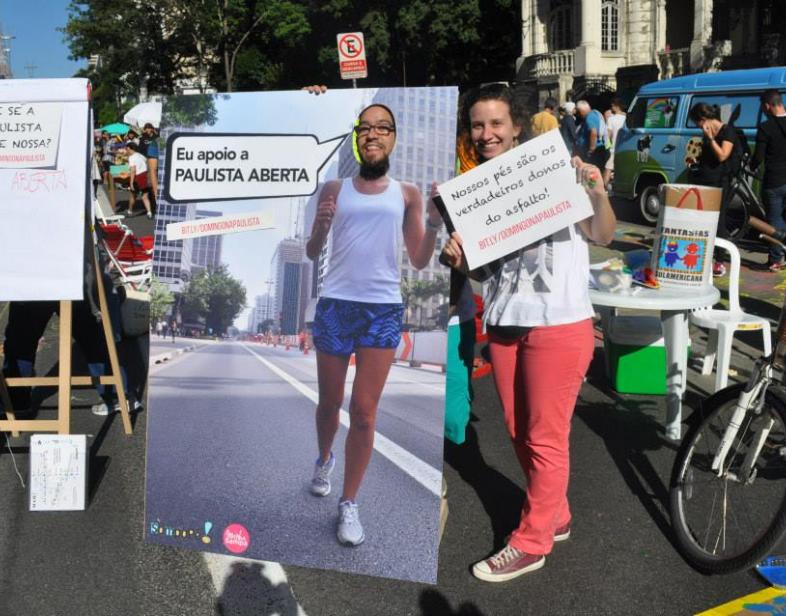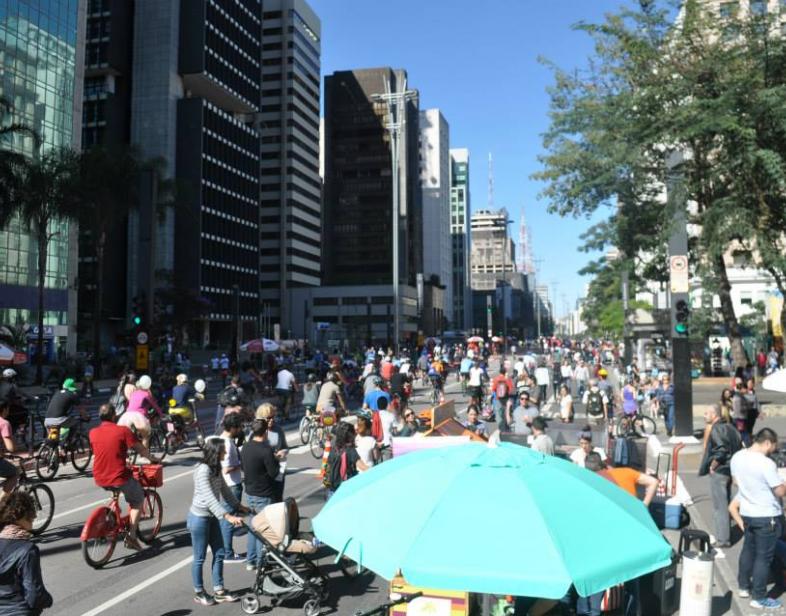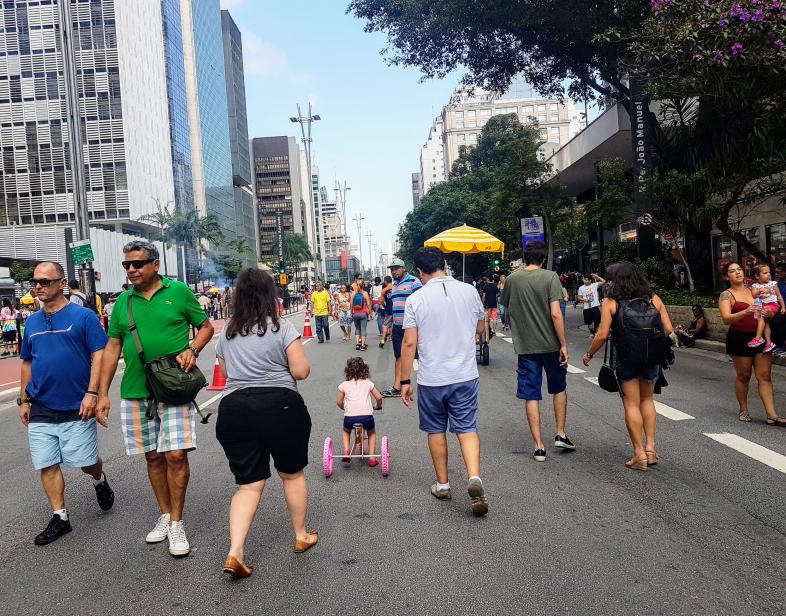An Overview Of Our Solution
São Paulo, like other megacities and urban centers, has developed itself visioning automobiles and private spaces culture. However, nowadays, it is evident that the results of this model are neither positive for citizens nor for the city, generating a great disconnect between people and urban space and high costs for people and the city. Said that, more recently some urban movements started to make projects, actions and advocacy in order to create ways to reconnect people with public spaces and with other people. In this context, SampaPé! created and has advocate for what is now the greatest example of reappropriation of the city space demanded by the civil society: Paulista Aberta, an open streets project in one of the major avenues of the city, making evident that street spaces is public spaces and can be addressed to people, and every citizen win.
- Population Impacted: 11,000,000 people (São Paulo population)
- Continent: South America
Context Analysis
In one hand, São Paulo has more than 7 million private cars registered and average traffic congestion of 180km. The main causes of death in the city are heart and respiratory diseases, both related to the air pollution and lack of physical activity. Besides that, 6 people per week are killed hit by motorized vehicles - people die for the only reason of moving around. High speed streets and several urban highways with no pedestrian crossing are common scenery in urban centre. In the other hand, walking is the major mean of transportation, representing ⅓ of all daily trips - however many of walking trips occur by lack of other transport options.
Even though the model of the city is evidently impracticable, cars and speed are venerated, and any project that implies changing street spaces or speed are massively criticised.
In this context, SampaPé! works to change the current situation, improving walking experience in the city by promoting the walking culture and humanizing the city.
Describe the technical solution you wanted the target audience to adopt
The solution we propose is people change behaviour by experimenting a good environment, created by
the change of use of the streets.
Type of intervention
Describe your behavioral intervention
The behaviour intervention we proposed was an open street project on Sundays and Holidays in a major avenue in the city, Avenida Paulista. Impacting directly on the people use of public spaces and habits but also in the symbolic image and imaginary of the city. It consisted in the creation of the open street project and advocacy project in order to make it happens. The objective wa to bring diverse citizens, from different areas, backgrounds and social economical condition, together, in a public, democratic and free space. At the same time, reinvent road images and uses focused on people and walking. In order to do so, we made a public campaign, online and on streets, in which citizens were invited to join the pression in the mayor to open the street, and also to enjoy the street in a playful way every Sunday. In parallel we met and present the project to several decision makers in the city, pointing its benefits. After two years advocating, Paulista Aberta (open street Paulista Avenue) became a reality as a municipal programme to prioritize the pedestrians in the city, and more than that, it has spread to the whole city. Resulting in a project which every Sunday and Hollidays 27 streets in São Paulo are open for people and blocked for cars. The main evidence of it success is the recognition of the avenue as a public space for enjoyment, evidenced by its audience, with more than 100.000 people per open street day.
As needed, please explain the type of intervention in more detail
The intervention first consisted in advocacy and campaign to open a major avenue for people enjoyment by blocking it for motorized vehicles. When it was overcome the logistics to make it practically happen is very simple: traffic detours need to be signed for motorized vehicles, guaranteeing safety for the people in the road, and the project has to be communicated for the people to make people come and adapt. Besides that, on first events, we had the role, together with other cultural and urban groups, of organising some activities to make people understand new uses of the street, such as play, lie down, read, sunbath, learn to cycle, dance, listen to music, talk, make a pic nic, etc.
Describe your implementation
The implementation took 2 years of advocating, which have included three main strategies: online pressure, decision makers meetings, and street occupation. The online pressure were made through a partner NGO, Minha Sampa, online tool in which every citizen that wanted the open street project by joining it sent an email to the mayor asking for it. We also maped decision makers that could advocate for it, such as, sports secretary and tourism secretary, and met then to present the project looking for support in the municipal government. And we also made street occupations on the avenue in order to start changing it image and invite people to experience the avenue as a playful public space for people. The name used in the campaign was also strategical, instead of asking for the street to be closed, we asked the street to be open for people. Creating a new perspective of considering roads role and use.The main way of measuring the success of the project were by people using the street. We, together with two NGO (Cidade Ativa and Bike Anjo) measured people on Paulista Avenue on Sundays, and we found out that more than 100.000 people enjoy the open avenue every open street day. The main enabling condition for the project accomplishment was the cyclepath built in this major avenue which were already recreating the avenue with more equitable use of space in the city and promoting active ways of transport. The key factors to make it happen was our persistence and make the demant public and visible. The open street "experience" at the cycle path launch was the trigger for more citizens embrace the project and also decision makers and municipality, by realising its was possibility and potential. Dealing with the municipality were the main challenge, once the project depends on them to happen by politician are very worried about public opinion and massive media response. However, testing the project and engaging citizens were the way of overcoming it.
External connections
Minha Sampa was the partner NGO of the whole process of advocacy, also with its tools of pressure. During this process many other NGO and social companies related with city transformation for people got involved promoting and also bringing activities to the street occupation. We articulated our previous network but also connected with other interested organization during the process. Ben & Jerry's supported the campaign through making it visible to more people, and being present in some of the street occupation. During the street occupation phase and online campaign we also had to make it visible in the press and bring more people to make pressure into the municipality, so newspaper and TV programmes also got involved. Once municipality decided to create the programme, during the maintenance, mainly in order to guarantee its continuity by formulating a policy, other two NGO got involved as partners of the process: Cidade Ativa e Bike
Anjo. And to make the project reality, the municipality became a main partner, implementing the programme, creating an space of social participation for its the maintenance and making a policy of open streets. Our NGO led this process with no budget, but with a lot of time investment of our directors and other members. The other stakeholder of the process had spend some amount, such as Minha Sampa with their online platform and the municipality to make the programme a reality, by its logistics and policy making.
Who adopted the desired behaviors and to what degree?
The people who go to the street on Sundays and Holidays, mainly from São Paulo and surrounding cities, what improved the use of public spaces, social interactions and cultural expressions. The evidences are on going on the street and by people count as we mentioned before, average 100.00 people per open street day enjoying the open air public space together. This includes a high percentage of elder, children and people with disabilities.
How did you impact natural resource use and greenhouse gas emissions?
We could see the impact by pollution measurements made by the NGO Cidade Ativa, in which air pollution
and noise pollution was measured in a normal week day and during the open street project to show how it
changes. The images attached show this improvement.
What were some of the resulting co-benefits?
Health benefit - people exercising, learning to bike, skate and other. Space to run. Less air pollution and noise pollution. Mental health benefits.
Community benefit - people from different class, areas and interest getting together in the same place in a respectful and awareness of difference space.
Inclusivity - Once São Paulo sidewalks are not suitable for old people, and people with disabilities to move around it became an opportunity for them to be at the public space enjoying other people company and city's activities. And for children too, because of the speed and the cars streets became dangerou to be and play, it is a huge opportunity for being outside with no worries, living the city.
Cultural benefit - Diversity, space to present different cultural manifestation.
Democracy - Space for free with cultural and sports option for everyone, with no prejudice.
City Access - Easy access by public transport, safe for everyone, from babies to old people, giving opportunity for people on being on public spaces independent its personal condition in safe structure.
Sustainability
It is operated by the municipality, specifically by the municipal traffic engineer company, which makes the operation to guarantee the street is motorized vehicle free, for people safety and enjoyment. But it does not require a lot of investment because is only to make the operation to detour motorized from this streets and the use of the space is expontaneous created and reinvented by the citizens. What guaranty its permanence is people use and law support to reinforce it as a public policy independence on the government or party in power position. But it can also be attractive for sponsors, retail in the surrounds and other models.
Return on investment
We don't know the public investment in the project. But undoubtedly the results are much higher than the costs, because the
results are related to several areas, not only climate change and sustainability, but also health, culture, socialization, diverse interaction between people, inclusivity and other elements that were not measured yet.
How could we successfully replicate this solution elsewhere?
It has to be done in a partnership between social organizations, citizens and government. It has be already done in several different cities but through different process and in different ways, like Bogotá open streets project which started in the 80's but it happens only in the mornings and focused on sports and cycling. In order to do it is important to choose the right avenue, which is a combination of a symbolic avenue, with cultural offer on Sundays and and easy access by public transport. It is important to observe how the space is being appropriate and to create a group for the maintenance of the programme including government and civil society of different interests to constantly car for the street and its democratic and inclusive caracter.





